
01 December 22
Live on the homepage now!
Reader Supported News
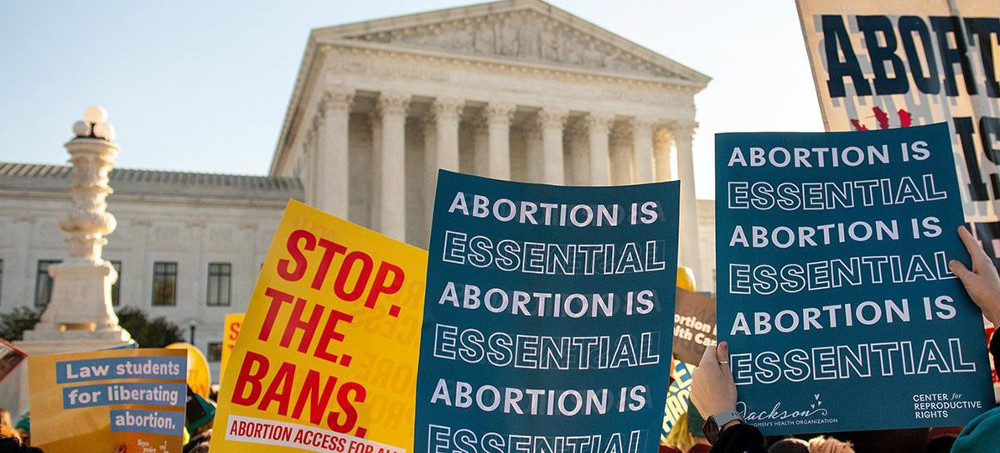
Lisa Tucker, Stefanie A. Lindquist | How the Supreme Court Is Erasing Consequential Decisions in the Lower Courts
The New York Times
Excerpt: "The Supreme Court is increasingly setting aside legally significant decisions from the lower courts as if they had never happened, invalidating them in brief procedural orders."
The Supreme Court is increasingly setting aside legally significant decisions from the lower courts as if they had never happened, invalidating them in brief procedural orders. The pace of these actions has increased in the past 22 months, neutralizing important civil rights and civil liberties decisions.
Reasoned opinions by the federal appeals courts on issues ranging from voting rights to Donald Trump’s border wall have been wiped from the books, leaving no precedent for the lower federal courts to follow. Legally, it is as if these decisions by the appeals courts, one rung below the Supreme Court, had never existed. The Supreme Court’s final, unilateral exercises of power in these cases have gone largely unreported.
The Supreme Court has broad discretion to decide which cases it hears and accepts only a small number each term. Appeals court decisions that the justices choose not to review typically remain in effect in the judicial circuit where they were decided, operating as precedent to be followed by that appeals court and the courts below it.
But when the Supreme Court vacates a lower court decision, that decision is erased, and any subsequent litigation on the issue must begin anew. Since January 2021, soon after Amy Coney Barrett took her seat on the Supreme Court, expanding the conservative majority, the court has relied on a 1950 decision to vacate 13 politically and legally significant decisions issued by federal appeals courts. That case, United States v. Munsingwear, held that when a case becomes moot during an appeal — meaning there is no longer a continuing controversy — the justices can vacate the decision with an order known as a vacatur.
The recent flurry of Munsingwear vacaturs is sharply at odds with the pace of past court practice. Since a 1994 Supreme Court decision scaled back the use of the Munsingwear precedent, the court has cited the case only 48 times to vacate lower court decisions, according to our research. Slightly more than half of those actions have occurred in just the past five years, after the appointment of Justice Neil Gorsuch, which maintained a 5-to-4 conservative majority. More than a quarter have come in the past 22 months, with the conservatives holding a 6-to-3 majority.
In most of the cases, the vacated federal appeals court opinions were written by judges appointed by Democratic presidents. (In some of the cases, the Biden administration sought the vacatur, probably because the lower court decided against the government and a Supreme Court decision affirming that ruling could restrict a future administration’s options.)
In 12 of the 13 lower court rulings vacated by the justices in the past 22 months, the court erased decisions that seemed to align with progressive values and objectives:
- Two that granted standing to plaintiffs suing Mr. Trump for violations of the emoluments clauses by profiting from his hotels and restaurants.
- One that held that Mr. Trump could not block critics on his Twitter account.
- One that allowed states to be sued directly under the Voting Rights Act.
- Two that allowed Pennsylvania election boards to count undated ballots or to extend mailing deadlines for ballots during the pandemic.
- Two that tossed out work requirements approved by the Trump administration for beneficiaries to receive Medicaid.
- One that held that the House of Representatives had standing to sue the executive branch for violations of its appropriations power in connection with Mr. Trump’s border wall.
- One that prohibited the Trump administration from returning asylum seekers to Mexico under its Migrant Protection Protocols.
- One that allowed the House Judiciary Committee to obtain redacted grand jury materials in its impeachment case of Mr. Trump.
- One upholding a preliminary injunction against an executive order issued by the governor of Tennessee during the pandemic blocking abortion procedures for three weeks.
In another case during the same period, an appeals court upheld an executive order by Gov. Greg Abbott of Texas to prohibit most abortions at the beginning of the pandemic. The order had expired and been replaced, and the court agreed with Planned Parenthood that the case was moot and vacated it.
The most recent vacatur involved a Pennsylvania election dispute that the losing candidate asked the court to vacate. The U.S. Court of Appeals for the Third Circuit had allowed the local election board to count mail-in ballots that did not comply with a state law requiring voters to write the date on the ballot’s outer envelope, on the grounds that the omissions were not material to determining the voter’s qualifications. (One of us, Lisa Tucker, consulted on strategy in this case with her husband, Adam Bonin, a lawyer who had argued against vacating it.)
The appeals court decision had implications for future elections, and two of the court’s three more liberal justices, Sonia Sotomayor and Ketanji Brown Jackson, would have declined to accept the case but would not have vacated it, leaving the Third Circuit’s decision intact. Nevertheless, at least five justices voted to vacate.
In recent months, many scholars have noted the court’s seeming disregard for precedent in big, headline cases, such as its overturning of Roe v. Wade on abortion. In the months ahead, the court may well overrule other longstanding decisions. But at least in such cases, the justices will offer their reasoning.
READ MORE
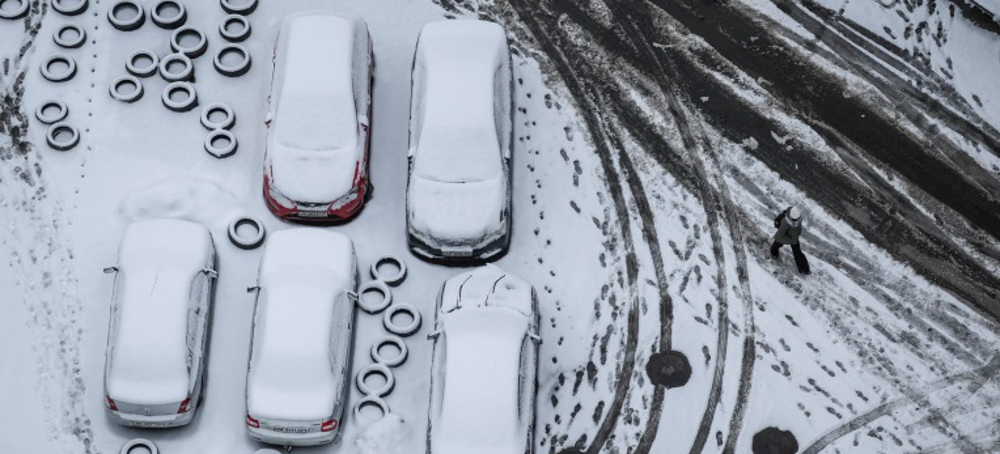 A pedestrian passes by cars covered in snow, in Kyiv, Ukraine, November 30, 2022. (photo: Gleb Garanich/Reuters)
A pedestrian passes by cars covered in snow, in Kyiv, Ukraine, November 30, 2022. (photo: Gleb Garanich/Reuters)
Winter Starts, Ukraine Goes Dark: Fear and Resolve in Blackouts
Rory Challands, Al Jazeera
Challands writes: "I'm not much of a fighter, but I know the feeling. And if you've ever prepared to take a punch to the stomach, you know the feeling, too."
Al Jazeera’s Rory Challands, reporting in Kyiv, on how Ukrainians are trying to cope in the dark.
I’m not much of a fighter, but I know the feeling. And if you’ve ever prepared to take a punch to the stomach, you know the feeling, too.
The intake of breath. The tensing of the muscles. The knowledge that the blow is coming. The hope that it won’t be too painful.
That’s what it’s like in Ukraine, waiting for the next wave of Russian missile strikes.
Everyone knows it’s inevitable. It’s just a question of when. And how bad.
Since October 10, every few days, Russia has deployed its strategic bombers and warships to unleash aerial devastation on Ukraine’s critical infrastructure.
Cruise missiles have smashed into power plants and water facilities.
Most are shot down by Ukrainian air defence. But enough get through to take large parts of the energy grid down completely.
For days after, people shiver in dark, cold homes. They cook on camping stoves in candlelit kitchens. They put on all their clothes to sleep and cover themselves with every blanket they own.
Engineers work double or triple shifts to repair or replace fried circuits and blackened transformers. After a few days, the power is fixed.
Then, Russia does it again.
Cumulatively the effect is bringing the country’s energy network to its knees. Capacity has been significantly reduced. Emergency and scheduled blackouts continue, even when the power is restored.
Ukraine and its allies say that Russia is using winter as a weapon – and it’s hard to disagree with that.
And while Ukraine insists Russia is committing a war crime, the international laws of warfare are not so clear cut.
Electrical systems can be claimed as legitimate targets if they’re used by the military, as well as civilians. Most militaries do, and Ukraine’s is no exception. The United States has targeted energy infrastructure in North Korea, Vietnam, and Iraq.
The other day, I went out with the team to film in Kyiv’s suburbs on a gloomy, powerless, late autumn day.
The recent snow was starting to show its age – thawing into big, dirty brown puddles as the temperature hovered just above zero. At random, we stopped at a looming Soviet-era residential tower block.
We turned our head torches on in the pitch-black lobby. Our frosty breath billowed in the beams of light as we trudged up seemingly endless flights of stairs.
On the eighth floor, we tried a few doors.
The only one to open was Alyona’s. And amazingly, she welcomed in the strange men loitering in the dark corridor.
Alyona lives in a two-room flat with her toddler son and her truck driver husband.
She’d rigged up battery-powered fairy lights to combat the murk.
“Like Christmas atmosphere in November,” she said with a grin. The family sleeps in the same bed which helps to keep warm.
I asked Alyona what effect the air strikes and the blackouts were having on morale.
“No one I know is ready to have negotiations with Russia because of these strikes,” she told me. “It just makes us hate them more.”
It’s the type of defiance you hear much of in Ukraine. The message is simple: If living without electricity means Ukrainians can live without Russia, then they say they’ll take it.
I chose to film my reporter’s piece to camera back out on the tower block’s chilly stairwell.
Between takes, we paused. Voices were reverberating up from far below. It seemed an age until their owners reached us.
It was a woman, Lyudmilla, and her two kids. She was staggering up with one of the children in her arms, puffing on the stairs as she cursed the Russians flamboyantly.
As she passed us, she smiled and gasped the words that have become the national greeting since the war began: “Slava Ukraiina!” – Glory to Ukraine.
READ MORE
 Elon Musk says he’s launching a ‘war’ against Apple. It’s probably a losing battle. (photo: AP)
Elon Musk says he’s launching a ‘war’ against Apple. It’s probably a losing battle. (photo: AP)
Elon Musk Says He's Launching a 'War' Against Apple. It's Probably a Losing Battle.
Naomi Nix, The Washington Post
Nix writes: "Elon Musk launched a tirade against Apple this week after he said the phone-maker had mostly stopped advertising on Twitter and threatened to block the social media giant from its app store."
Elon Musk says he’s launching a ‘war’ against Apple. It’s probably a losing battle.
On Wednesday, Elon Musk tweeted that he had met with Apple’s Tim Cook and struck a much conciliatory tone than he had adoped earlier in the week. “Thanks @timcook for taking me around Apple’s beautiful HQ,” the Twitter CEO tweeted, posting a video of a pond at the headquarters. In a separate tweet, Musk said Cook had assured him that Apple had never considered removing Twitter from its App Store.
Elon Musk launched a tirade against Apple this week after he said the phone-maker had mostly stopped advertising on Twitter and threatened to block the social media giant from its app store.
In some ways, the billionaire seemed to be picking a losing fight. The amount Apple spends advertising on Twitter and the rules it sets for apps in its app store could play a big role in whether Twitter will be able to generate enough revenue to make Musk’s $44 billion deal to buy the platform worth it.
“If there’s one company for him not to pick a fight with in the world, it’s Apple, and he just poked the bear,” said Dan Ives, a financial analyst with Wedbush Securities. “It’s just another head-scratching battle that Musk has waged since his ownership of Twitter.”
In a series of tweets, Musk criticized Apple’s app store as a “monopoly” and raised whether the phone-maker supported censorship. Musk also signaled in a tweet that he intends to “go to war” with Apple.
It’s a risky strategy. Apple wields significant power over Twitter as the social media platform seeks to diversify its advertising business and boost subscription sales, according to experts. For starters, Twitter depends on Apple to reach the tens of millions of people who use Apple devices to search the web — a large and attractive market for the social media giant.
At the same time, Apple’s privacy rules probably will hurt Musk’s plans to build out Twitter’s targeted advertising business. And the 30 percent fee Apple extracts from app sales could put a dent in Musk’s plan to make money from subscriptions.
Musk joins a long line of other app-makers and regulators that have, so far, unsuccessfully sought to significantly rein in the power Apple wields over social media platforms. Facebook has launched a similar unsuccessful public relations campaign against Apple’s privacy rules, which cost Facebook billions in lost ad sales. Lawmakers to date have been unable to pass legislation that would give users the ability to download apps outside of Apple and Google’s app stores. And courts in the United States have so far not compelled Apple to significantly change the fees it collects on app sales.
Musk said Monday that Apple had threatened to remove Twitter from its app store; Apple has yet to confirm or deny the allegation. If Apple were to block Twitter from its App Store, new users would be unable to download the Twitter app on their iPhones and iPads, and existing users would be unable to access updates — a prospect that could devastate Twitter’s ability to grow its user base, experts say.
Musk’s public criticism of Apple also stands out in part because of how central the phone-maker was to Twitter’s advertising business. In the first quarter, Apple was the top advertiser on Twitter, spending $48 million on ads on the social network, according to a document reviewed by The Washington Post that was compiled from internal Twitter data. Apple’s spending accounted for more than 4 percent of Twitter’s revenue that quarter, The Post has reported.
Before Musk bought the platform, Apple often turned to Twitter to launch glitzy promotions of its new devices such as the latest iteration of the iPhone.
“Apple has put Twitter at the center of their product launch efforts and they have produced epic events on Twitter,” said Lou Paskalis, a frequent Musk critic and member of the Twitter Influence Council, a group of advertisers who offer feedback to the company. “I would be sending flowers, candy and chocolates to Apple.”
Apple also wields significant power over Twitter’s ability to diversify the way it generates advertising revenue, which is how it makes the lion’s share of its money. Twitter is best known for being a platform that big corporations turn to increase awareness of their companies in front of a large and diverse audience through broad brand advertising campaigns.
More recently, though, Twitter has sought to mimic some of Facebook parent Meta’s success by improving its ability to allow marketers to target their advertising campaigns to a narrowly tailored section of users who are most likely to buy the product after seeing or clicking on the ad — a phenomenon known as direct-response marketing. Twitter said this year that the revenue split between brand and direct-response advertising was 85-15, but the company has been striving to reach a more even split in the future.
But privacy rules Apple imposed in April 2021 could limit Twitter’s ability to give marketers enough data on users to effectively target ads. Apple’s rules forced apps such as Facebook and Twitter to explicitly ask users if they could track their activity across the internet — a request many people turned down. Meta has estimated that Apple’s rules will have cost it $10 billion this year and has argued publicly that the moves would hurt small businesses that don’t have a lot of money to spend on marketing.
“It’s an uphill battle for Twitter to get brands on board [and] get retailers on board to do that in the first place,” said Andrew Lipsman, an analyst at market analysis firm Intelligence Insider.
Additionally, Apple could affect Musk’s ability to generate revenue from new subscriptions. Musk this month allowed any user who paid an $8 subscription fee to obtain a blue check mark verification badge — a designation once reserved for public figures. The program was later paused after users began impersonating businesses, political leaders, government agencies and celebrities.
Even if Musk successfully restarts the program, Apple’s rules could limit how much money it manages to collect. Apple charges developers a 30 percent fee on most purchases made inside apps, though sometimes Apple charges 15 percent for smaller developers. That fee could have “a significant impact on the potential revenue for a subscription business,” said Lipsman, cutting every $8 collected to just $5.60.
That issue could win Musk allies in the tech world. Tech companies such as Spotify and Fortnite maker Epic Games have long criticized Apple for imposing the fees, and last year a federal judge ruled in a lawsuit filed by Epic that Apple must allow app developers to “steer” customers to alternative payment processing services. But the judge declined to rule Apple’s App Store a monopoly, and Apple still cast the ruling as a victory.
Epic Games founder Tim Sweeney used Musk’s disagreement with Apple as an opportunity to press its case again in public.
“Apple is a menace to freedom worldwide,” Sweeney tweeted Monday. “They maintain an illegal monopoly on app distribution, they use it to control American discourse, and they’re endangering protesters in China by storing sensitive customer data in a state-owned data center.”
But it seems unlikely Musk’s adherence to Epic’s position will make a major difference.
Lawmakers so far have taken little action to curb Apple’s power. Legislation that would force Apple and Google to allow people to download apps outside of their stores and allow them to install alternative stores has gone nowhere, and the bills are viewed as unlikely to pass under Republican leadership in the House.
Without regulatory action that forces Apple’s hand, Musk probably faces an uphill battle attempting to shame Apple into adopting more favorable rules, experts say.
“Twitter certainly needed Apple much more than Apple needed Twitter,” Paskalis said.
READ MORE
 Underwater at the Great Barrier Reef. (photo: iStock)
Underwater at the Great Barrier Reef. (photo: iStock)
Australia Argues Against 'Endangered' Barrier Reef Status
Associated Press
Excerpt: "Australia's environment minister said Tuesday her government will lobby against UNESCO adding the Great Barrier Reef to a list of endangered World Heritage sites, arguing that criticisms of government inaction on climate change were outdated."
Australia's environment minister said Tuesday her government will lobby against UNESCO adding the Great Barrier Reef to a list of endangered World Heritage sites, arguing that criticisms of government inaction on climate change were outdated.
Officials from the U.N. cultural agency and the International Union for Conservation of Nature released a report on Monday warning that without "ambitious, rapid and sustained" climate action, the world's largest coral reef is in peril.
The report, which recommended shifting the Great Barrier Reef to endangered status, followed a 10-day mission in March to the famed reef system off Australia's northeast coast that was added to the World Heritage list in 1981.
Environment Minister Tanya Plibersek said the report was a reflection on Australia's previous conservative government, which was voted out of office in May elections after nine years in power.
She said the new center-left Labor Party government has already addressed several of the report's concerns, including action on climate change.
"We'll very clearly make the point to UNESCO that there is no need to single the Great Barrier Reef out in this way" with an endangered listing, Plibersek told reporters.
"The reason that UNESCO in the past has singled out a place as at risk is because they wanted to see greater government investment or greater government action and, since the change of government, both of those things have happened," she added.
The new government has legislated to commit Australia to reducing its greenhouse gas emissions by 43% below the 2005 level by 2030.
The previous government only committed to a reduction of 26% to 28% by the end of the decade.
Plibersek said her government has also committed 1.2 billion Australian dollars ($798 million) to caring for the reef and has canceled the previous government's plans to build two major dams in Queensland state that would have affected the reef's water quality.
"If the Great Barrier Reef is in danger, then every coral reef in the world is in danger," Plibersek said. "If this World Heritage site is in danger, then most World Heritage sites around the world are in danger from climate change."
The report said Australia's federal government and Queensland authorities should adopt more ambitious emission reduction targets in line with international efforts to limit future warming to 1.5 degrees Celsius (2.7 degrees Fahrenheit) since pre-industrial times.
The minor Greens party, which wants Australia to slash its emissions by 75% by the end of the decade, called for the government to do more to fight climate change in light of the report.
Jodie Rummer, a marine biologist at James Cook University in Townville who has worked on the reef for more than a decade, supported calls for Australia to aim for a 75% emissions reduction.
"We are taking action, but that action needs to be much more rapid and much more urgent," Rummer told Australian Broadcasting Corp.
"We cannot claim to be doing all we can for the reef at this point. We aren't. We need to be sending that message to the rest of the world that we are doing everything that we possibly can for the reef and that means we need to take urgent action on emissions immediately," she added.
Feedback from Australian officials, both at the federal and state level, will be reviewed before Paris-based UNESCO makes any official proposal to the World Heritage committee.
In July last year, the previous Australian government garnered enough international support to defer an attempt by UNESCO to downgrade the reef's status to "in danger" because of damage caused by climate change.
The Great Barrier Reef accounts for around 10% of the world's coral reef ecosystems. The network of more than 2,500 reefs covers 348,000 square kilometers (134,000 square miles).
Australian government scientists reported in May that more than 90% of Great Barrier Reef coral surveyed in the latest year was bleached, in the fourth such mass event in seven years.
Bleaching is caused by global warming, but this is the reef's first bleaching event during a La Niña weather pattern, which is associated with cooler Pacific Ocean temperatures, the Great Barrier Reef Marine Authority said in its annual report.
Bleaching in 2016, 2017 and 2020 damaged two-thirds of the coral.
Coral bleaches as a response to heat stress and scientists hope most of the coral will recover from the latest event.
READ MORE
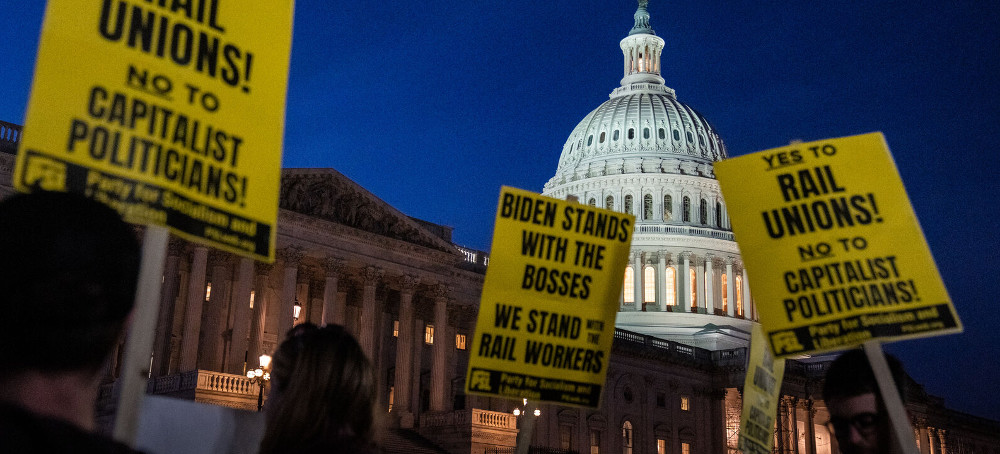 Wednesday’s action by the House was the first time since the 1990s that Congress had used its power under the Railway Labor Act to intervene in a national rail labor dispute. (photo: Haiyun Jiang/The New York Times)
Wednesday’s action by the House was the first time since the 1990s that Congress had used its power under the Railway Labor Act to intervene in a national rail labor dispute. (photo: Haiyun Jiang/The New York Times)
House Votes to Pass Bill Forcing Rail Labor Deal to Avoid Strike
Lauren Kaori Gurley and Liz Goodwin, The Washington Post
Excerpt: "The House voted Wednesday to force a deal between freight rail carriers and unions, blocking a potential strike that threatened travel, supply chains and the busy holiday shopping season."
The legislation heads to the Senate, where its path appears more fraught
The House voted Wednesday to force a deal between freight rail carriers and unions, blocking a potential strike that threatened travel, supply chains and the busy holiday shopping season.
The legislation heads to the Senate, where its path could be more fraught, but leaders of both parties have vowed to act quickly.
Without a deal, the unions are poised to strike as early as Dec. 9. Four of 12 unions involved had voted down a contract, brokered by the White House, that lacked paid sick days or changes to an attendance policy that rail workers say is punitive. A shutdown of the nation’s railway systems could cost the economy as much as $2 billion a day, according to the rail carriers trade group.
The House voted 290-137, with bipartisan support, on the bill that would force the rail deal that was brokered by the White House. But the chamber also narrowly approved a separate version of the rail deal, 221-207, to give rail workers seven paid sick days, a move that liberal Democrats in the House, as well as Sen. Bernie Sanders (I-Vt.), have pushed for.
“Today we are here to safeguard the financial security of America’s families, to protect the American economy as it continues to recover and avert a devastating nationwide rail shutdown,” House Speaker Nancy Pelosi (D-Calif.) said at the start of the floor debate.
Both bills head to the Senate, but timing on the votes there is uncertain.
Shortly after the House action, President Biden urged the Senate to act quickly to avert a rail strike.
“Without the certainty of a final vote to avoid a shutdown this week, railroads will begin to halt the movement of critical materials like chemicals to clean our drinking water as soon as this weekend,” Biden said in a statement. “Let me say that again: Without action this week, disruptions to our auto supply chains, our ability to move food to tables, and our ability to remove hazardous waste from gasoline refineries will begin.”
The bizarre politics around the rail strike — with the economic threat of an infrastructure shutdown prompting a pro-union Democratic president to push an agreement despite some union workers’ objections — makes it harder to predict the bill’s path in the Senate.
Several liberal senators, including Sanders and Elizabeth Warren (D-Mass.), were pressing to adopt the version of the agreement that included paid sick days, while moderate Sen. Joe Manchin III (D-W.Va.) said he was undecided on whether he’d vote to add the sick days. Labor Secretary Marty Walsh and Transportation Secretary Pete Buttigieg are expected to talk with Democrats about the agreement on Thursday.
On the Republican side, at least one senator, Josh Hawley of Missouri, said he would only favor an agreement that included sick days. “I will absolutely not support it without some sick leave,” he said. Others who previously seemed open to adding the leave, including Sen. John Cornyn (Tex.), walked back that support on Wednesday, saying they did not wish to alter an agreement that had already been reached.
“I doubt very much it makes sense for us to try to rewrite the agreement,” said Sen. Patrick J. Toomey (R-Pa.) about the addition of sick days.
Sen. Susan Collins (R-Maine), a moderate who can often be relied upon to take politically tough bipartisan votes, urged Biden to “convene both sides” at the White House and work out another deal instead of having Congress impose one. “To overturn the workers’ rejection of the proposal, especially when it centers around sick leave, is troubling to me,” she said.
But many Republicans sounded wary of allowing a strike to disrupt the nation’s economy, even if they were undecided on how they would vote on the deal. “I don’t think the country can stand a rail strike,” Sen. Mike Braun (Ind.) said. “The economy has been so screwed up over the last two years with the supply chain and other issues.”
Even among Democrats, there was disagreement on the path forward. A group of 12 liberal senators released a statement saying the Senate must make the deal “better.”
Sanders declined to say on Wednesday whether he would vote for the underlying agreement if he is able to take a separate vote on paid leave.
In recent weeks, four rail unions out of 12 voted down the tentative agreement brokered with help from the White House. That deal offers union members a 24 percent raise by 2024, annual bonuses of $1,000 and a cap on health-care premiums. Carriers also agreed to give conductors and engineers a single additional paid day off and new flexibility to take off work three times a year for routine health appointments without fear of discipline.
But many workers argue that these gains do not address issues related to chronic understaffing that prevent them from going to the doctor and dealing with emergencies, as well as the lack of paid sick days.
Rail carriers have said they need to maintain their attendance policies to ensure the railroads are adequately staffed. They say employees can take time off when they are sick by using paid vacation days.
Ian Jefferies, president of the Association of American Railroads, the industry trade group negotiating on behalf of carriers, said he did not support adding paid sick days to the deal.
“The House is considering a new measure to the equation based on the wholly false premise that rail employees do not get paid sick leave,” Jefferies said. “The ramifications of approving such a measure would disincentivize future voluntary agreements for freight railroads.”
Michael Baldwin, president of the Brotherhood of Railroad Signalmen, one of the four unions whose members voted down the deal, said his union members were disappointed with Biden’s call to Congress to impose the deal. But he is optimistic they can get paid sick days into their contract.
“We’re very happy with the vote results from the House today on the resolution to [get sick days],” Baldwin said. “We’re trying to work within the Senate to see if we can get support, and we’re actually starting to get support from people.”
Matt Weaver, a carpenter with the rail maintenance workers union, which voted against the deal, said he is hopeful that some Senate Republicans will join Democrats to pass the measure in the Senate that grants workers sick days.
“I think some Republicans would be embarrassed not to vote for sick days,” Weaver said. “Politicians are scared for their jobs.”
The pressure is on lawmakers to pass a bill and get it to Biden’s desk by Saturday, to avoid delays of critical supplies, ahead of the Dec. 9 strike deadline.
“He is very clear about that, because we need to protect American families from potential devastating effects of a rail shutdown,” White House press secretary Karine Jean-Pierre told reporters Wednesday. “Of course, [Biden] supports paid sick leave for all Americans, including rail workers, but he does not support any bill or amendment that will delay getting this bill to his desk by this Saturday.”
READ MORE
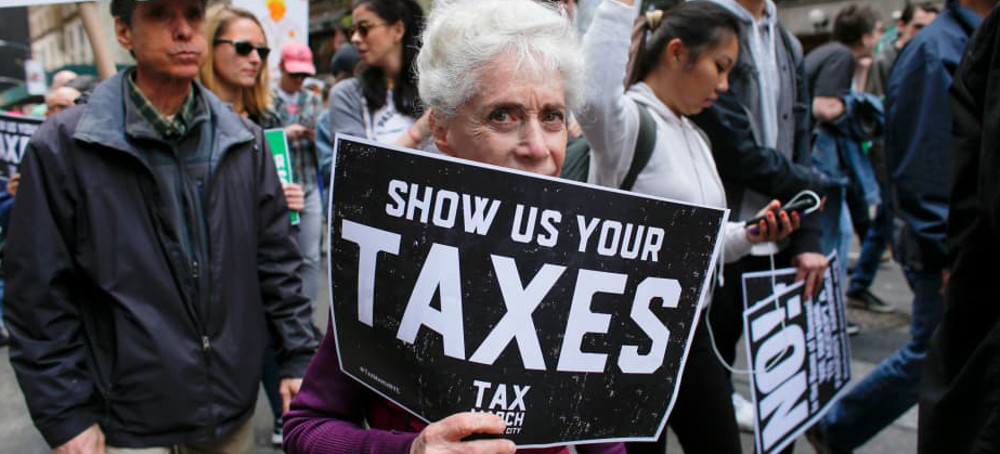 Protestors take part in the ‘Tax March’ calling on President Donald Trump to release his tax records on April 15, 2017 in New York. (photo: Mark Ralston/Getty)
Protestors take part in the ‘Tax March’ calling on President Donald Trump to release his tax records on April 15, 2017 in New York. (photo: Mark Ralston/Getty)
Trump's Tax Returns Now in the Hands of House Democrats After Lengthy Court Battle
Ali Vitali and Rebecca Shabad, NBC News
Excerpt: "A Democratic-led House committee now has access to six years of former President Donald Trump's tax returns after a multiyear court fight."
The Supreme Court paved the way last week for the Democratic-led House Ways and Means Committee to gain access to six years of Trump's financial records.
ADemocratic-led House committee now has access to six years of former President Donald Trump’s tax returns after a multiyear court fight.
The Treasury Department said Wednesday that it had complied with last week's Supreme Court decision that paved the way for the returns to be handed over to the House Ways and Means Committee.
The committee didn’t immediately respond to a request for comment. CNN first reported that the committee had received the tax returns.
Even though the Treasury Department said it has complied with the court’s decision, it’s unclear whether anyone on the committee has seen the tax returns at this point or what the process will be for accessing them.
A Treasury spokesperson declined to say whether the committee had accessed the documents.
Ways and Means Committee members are meeting Thursday, and lawmakers expect to learn more about Trump’s taxes then, a Democrat on the panel said.
“I’m not sure yet if we will see his taxes then or if we are just going to be walked through them,” the lawmaker said.
It’s unclear what House Democrats plan to do with the documents, especially as they face a GOP takeover of the House in January. Republicans have made it clear they’re not interested in or concerned about Trump’s tax records.
Asked Wednesday about the next steps, Committee Chairman Richard Neal said, "I can't talk about that."
Neal, D-Mass., also noted that he was legally obligated not to disclose much information about handling Trump's records.
"I’ll have better answers [after meeting] with the attorneys," he said.
Bill Pascrell, D-N.J., a Ways and Means Committee member and early proponent of pushing to obtain Trump’s tax returns, said Wednesday that the panel "will make a deliberative decision [on Trump's tax records] by Jan. 3," when Republicans officially take control of the House.
Asked whether he would consider making the tax returns public, Pascrell said: “I would.”
The records were transferred shortly after the Supreme Court rejected Trump’s last-ditch plea to block their release to House Democrats, just weeks before Republicans take the majority.
Chief Justice John Roberts temporarily blocked the Ways and Means Committee from accessing Trump’s tax records this month while the court decided how to act on Trump's request.
Unlike other recent presidents, Trump has refused to make his tax returns public amid scrutiny of his business affairs, repeatedly claiming he is being audited by the IRS.
Democrats have been demanding to see the records since the 2016 presidential campaign. But the legal battle began in April 2019, shortly after Democrats took control of the House, when Neal asked for Trump’s returns and those of related business entities. He said he sought the information as part of the committee’s inquiries into whether tax law concerning presidents should be amended.
The Treasury Department refused to comply with Neal's request during Trump’s presidency, saying in May 2019 that he didn’t have a valid legislative purpose for obtaining the documents. The committee sued two months later in what would become a lengthy battle to secure the returns.
For years, leading tax analysts have said the records must be provided to Congress because, under federal law, if the chairs of the Ways and Means Committee, the Senate Finance Committee or the Joint Committee on Taxation formally request a person’s tax returns, Treasury Department officials "shall" turn the documents over.
READ MORE
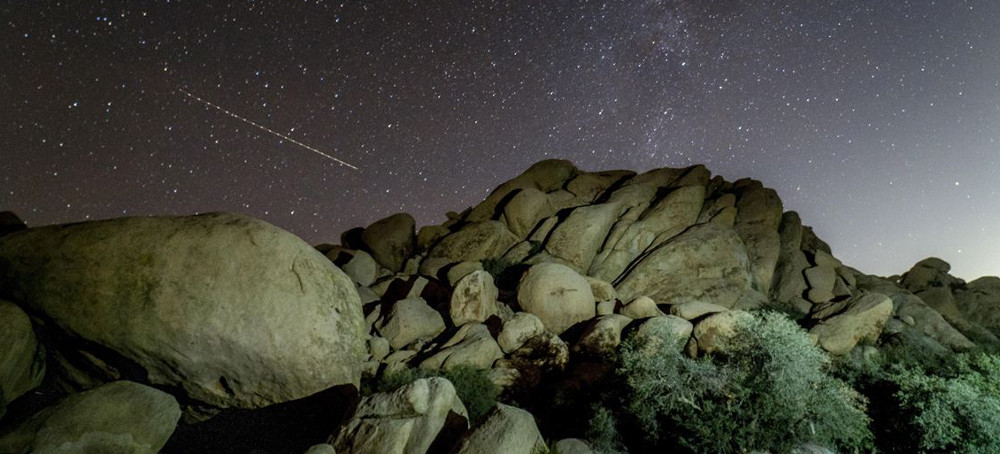 The night sky looms over the Knob Hill area of the proposed Avi Kwa Ame National Monument in Boulder City, Nev. (photo: Kyle Grillot)
The night sky looms over the Knob Hill area of the proposed Avi Kwa Ame National Monument in Boulder City, Nev. (photo: Kyle Grillot)
Biden Commits to Honoring Tribes by Protecting Public Lands in Nevada
Dan Michalski, The Washington Post
Michalski writes: "From the highway, Spirit Mountain — a 5,642-foot-high peak — appears gray. But, at times, it glows a majestic pink. For the Fort Mojave and 11 other tribes, these mystical rocks are the site from which their ancestors emerged."
The president pledged Wednesday to put hundreds of thousands of acres off limits to development in southern Nevada around Spirit Mountain, a sacred tribal site. A broad coalition backs the move, but renewable energy firms have raised concerns.
From the highway, Spirit Mountain — a 5,642-foot-high peak — appears gray. But, at times, it glows a majestic pink. For the Fort Mojave and 11 other tribes, these mystical rocks are the site from which their ancestors emerged.
“There’s a spiritual connection that makes us Mojave people,” said Tim Williams, chair of the tribal council. “If it’s not protected, our generation will not have done our job.”
Two decades ago, Congress preserved the mountain — called Avi Kwa Ame (ah-VEE-kwah-may) in Mojave — and 33,000 acres around it as wilderness. Now the Biden administration is readying a proclamation that could put roughly 450,000 acres — spanning almost the entire triangle at the bottom of the Nevada map — off limits to development under the 1906 Antiquities Act.
When finalized, it will probably rank as the largest act of land conservation that President Biden will undertake this term, in a spot within comfortable driving distance of Las Vegas. And although tribes have often been pressured to make concessions in the past, this marks a rare instance in which they have driven the process — bolstered by the support of environmental groups, lawmakers and the rural business community.
At the White House Tribal Nations Summit on Wednesday, Biden committed to conserving the area and noted that he had invoked the Antiquities Act last year to restore protections to three national monuments.
“Look, there’s so much more, there’s so much more that we’re going to do to protect the treasured tribal lands,” he told the group of tribal leaders. “When it comes to Spirit Mountain and surrounding ridges and canyons in southern Nevada, I’m committed to protecting this sacred place that is central to the creation story of so many tribes that are here today.”
“And I look forward to being able to visit Spirit Mountain and experience it with you as soon as I can,” he added.
Sitting between the Mojave National Preserve on the California side and Lake Mead National Recreation Area along the border of Nevada and Arizona, this 700-square-mile expanse will allow desert tortoises, bighorn sheep, golden eagles and dozens of other species to live and migrate uninterrupted.
“This is the missing link connecting the Mojave Desert and the Colorado Plateau,” said Neal Desai, a senior project manager for the National Parks Conservation Association who has been working for more than a dozen years to protect the area.
Some renewable energy advocates warn it could undercut the nation’s climate goals. But wind and solar companies, Desai said, will have to stay on the other side of the monument boundaries.
When it comes to having a chance to protect this much land, he added, “this really doesn’t happen very often. Not at this scale.”
Squeezing out solar?
In mid-November, nearly 250 people gathered at the Aquarius casino resort in Laughlin, Nev., for a two-hour public hearing with officials from the Interior Department’s Bureau of Land Management to discuss the prospective monument. A little more than two months before, Interior Secretary Deb Haaland had visited the area and held a roundtable on the topic with Rep. Susie Lee (D-Nev.).
Amid a standing-room-only crowd at the casino, only about half of the monument’s backers got time to speak.
“Today is special,” Williams said. “We’ve established a map. It’s been a collaboration of a lot of different people, a lot of organizations. … This is something that you don’t see every day, especially in this day and age, in this type of political environment. You don’t see this type of collaboration, and it’s here, and it’s now.”
Tribes spread out along the Colorado River have adopted resolutions endorsing a monument, including 27 of 28 tribes in the Inter-Tribal Council of Nevada and all 21 in the Inter Tribal Association of Arizona.
Several sent representatives to Laughlin, offering their two-minute testimonies about how ancient sites in the area are still an active part of their lives. Artists, environmentalists, birdwatchers, dark night-sky preservationists, hunters and off-road-vehicle enthusiasts also showed up to voice support for the monument.
Frank DeRosa, vice president for policy and public affairs for the solar energy firm Avantus, said he supported the creation of a monument but asked BLM to consider “a modest request” for a small adjustment to the map: a “sliver,” he called it, that “avoids all cultural and environmentally sensitive areas,” so renewable energy companies can access transmission infrastructure from a long-decommissioned coal-fired plant in Laughlin.
This expanse of Nevada offers some of the best prospects for clean energy development in the country. The canyons here produce tremendous wind, and the sun shines 292 days per year, usually without any cloud cover. The area also boasts dozens of mining claims for rare earth elements, now coveted by the clean tech sector.
Four massive solar farms loom along U.S. 95 between Las Vegas and Searchlight. More than 100 turbines from the White Hills wind farm in Arizona are visible from some of the higher points within the proposed monument.
The Avi Kwa Ame map, as it has been drawn, prevents similar projects from breaking ground. In previous negotiations with the town of Laughlin, the tribes agreed to exclude 23,000 acres from their proposal so a large solar project at the southern tip of Clark County could continue. But they would not make similar concessions for an area abutting California’s Dead Mountains Wilderness, on the grounds that the area is sacred.
Redrawing any portions of the plan now, Williams said, was not an option. “All the resolutions, all the agreements, were based on that map being presented as final.”
The BLM has identified more than 9 million acres of its land in the state for potential large-scale solar projects, according to Interior, and an additional 16.8 million acres for possible wind energy development. The federal government has classified roughly 83 percent of the area the tribes have proposed protecting as either wilderness or “areas of critical environmental concern” as part of an effort to conserve critical desert tortoise habitat.
A week ago, according to an individual familiar with the matter who spoke on the condition of anonymity to discuss private deliberations, the chief of staff to Nevada Gov. Steve Sisolak (D) met with an official from the White House Council on Environmental Quality to discuss the coming proclamation. Sisolak’s aide raised concerns about whether hunters had sufficient input into the process, this person said, and what effects the designation would have on renewable energy development.
Biden officials assured the governor’s office that hunters could continue to sustain artificial water sources, known as guzzlers, to attract bighorn sheep, according to the individual. The officials added that the state would be allowed to access and maintain existing infrastructure — including water resources and electric transmission lines — under any monument designation.
On Wednesday, Sisolak endorsed the idea in a Twitter thread, in which he thanked Biden and Interior officials for working with the state and other groups on the designation.
“Designating the sacred Tribal site of Spirit Mountain and the surrounding Mojave Desert as a national monument and providing for appropriate management will ensure we will continue to preserve our rich cultural history and protect our rare and threatened wildlife,” he tweeted.
Political climate change
For decades, activists had been working to safeguard key tribal, cultural and ecological lands in this region in a piecemeal fashion. But that strategy changed in 2017, when President Donald Trump scaled back three national monuments and voiced his support for industrial development.
“This was a big shift for the whole environmental community,” Desai said. “Not only did the Trump administration have a different outlook on public lands use, but we were seeing site-specific threats.”
In 2018, Crescent Peak Renewables — the American subsidiary of a Swedish wind power company, Eolus Vind AV — sought to build 248 wind turbines on 32,500 acres of BLM land in southern Clark County. Trump administration officials rejected the proposal, dubbed the Kulning Wind Energy Project.
Crescent Peak tried again last year, seeking access to just 9,300 acres to erect 68 turbines in a scaled-back version of the project. But BLM designated the application as “low priority,” effectively killing it.
“If we don’t do something, we’re going to lose this landscape,” said Alan O’Neill, a retired former superintendent for the Lake Mead National Recreation Area who consults for the National Parks Conservation Association.
The Fort Mojave tribe passed a resolution in September 2019 calling for protections of their ancestral lands extending far beyond Spirit Mountain, in a 381,300-acre national monument. By the time Rep. Dina Titus (D-Nev.) introduced a bill supporting the plan this year, the proposed size had expanded to 443,671 acres.
Monument supporters got a boost when Interior laid out a 10-year plan for locally led efforts to restore and conserve the country’s lands, water and wildlife in May 2021. The “America the Beautiful” initiative promised to protect 30 percent of the country’s lands and waters by 2030.
‘Gentle economic growth’
That’s when Kim Garrison Means, an artist, curator and college art instructor who lives in Searchlight (population 348), began going door to door to talk to residents about the proposed monument and to find out what it would take for them to support it.
Garrison Means, who lives a mile away from her nearest neighbor, said she talked to nearly everyone in town, making the case that people who loved their rural way of life needed to support this measure.
“It was still pretty covid-y at the time. Some people hadn’t seen other humans for quite some time,” Garrison Means said. “We did a lot of listening.”
She said she found strong support for protecting the land around Searchlight from industrial development. “You don’t appreciate what you have until people want to make changes to it.”
Although wind and solar companies promise good-paying construction jobs, the Avi Kwa Ame activists contend that having this national monument on their doorstep will welcome what Garrison Means calls “gentle economic growth”: businesses related to camping, hunting, birding, hiking, stargazing and other forms of outdoor recreation.
“It was surprising how together our community was,” she added. “It didn’t matter what flag they were flying outside their house. People wanted to protect this land.”
READ MORE
Contribute to RSN
Follow us on facebook and twitter!
Update My Monthly Donation
PO Box 2043 / Citrus Heights, CA 95611










